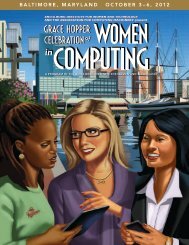ABI-ONE ghc program v14.indd - Grace Hopper Celebration of ...
ABI-ONE ghc program v14.indd - Grace Hopper Celebration of ...
ABI-ONE ghc program v14.indd - Grace Hopper Celebration of ...
Create successful ePaper yourself
Turn your PDF publications into a flip-book with our unique Google optimized e-Paper software.
Invited Technical Speakers<br />
Friday, sessiOn 9, 3:00 – 4:00 pm<br />
reGency baLLrOOm V<br />
Fernanda Viégas<br />
Research Scientist, Google<br />
From Politics to Art: Visualization as a Medium<br />
Data visualization has historically been accessible only to the elite<br />
in academia, business, and government. It was “serious” technology,<br />
created by experts for experts. In recent years, however, web-based<br />
visualizations — ranging from political art projects to news<br />
stories — have reached audiences <strong>of</strong> millions. Meanwhile, new<br />
initiatives in government, aimed at all citizens, point to an era <strong>of</strong><br />
increased transparency.<br />
What will this new era <strong>of</strong> data transparency and expressiveness look<br />
like — and what are the implications for technologists who work<br />
with data? To help answer this question, I report on work into public<br />
data analysis and visualization. Some <strong>of</strong> the results come from Many<br />
Eyes, a “living laboratory” web site where people may upload their<br />
own data, create interactive visualizations, and carry on conversations.<br />
Political discussions, citizen activism, religious conversations, game<br />
playing, and educational exchanges are all happening on Many Eyes.<br />
Finally, I discuss artistic projects that complicate and subvert the traditional<br />
notion <strong>of</strong> data visualization by highlighting its potential<br />
as an expressive medium that invites emotion.<br />
About Fernanda Viégas<br />
Fernanda B. Viégas is a computational designer<br />
whose work focuses on the social, collaborative, and<br />
artistic aspects <strong>of</strong> information visualization. She is a<br />
research scientist at Google, where she co-leads the<br />
visualization group with Martin Wattenberg.<br />
Her fascination with the power <strong>of</strong> visualization to<br />
spark conversation led to the creation <strong>of</strong> Many Eyes<br />
at IBM, where she was a researcher from 2005 to<br />
2010. The site is an open experiment in collective sensemaking and the impact<br />
<strong>of</strong> data analysis on public debate.<br />
Before joining IBM, Viégas’s research at the MIT Media Lab focused on the<br />
visualization <strong>of</strong> online communities. She is known for her pioneering work on<br />
depicting chat histories, email archives, and Wikipedia activity. Viégas’s interest<br />
in the stories that people tell about these archives led to a series <strong>of</strong> visualizations<br />
<strong>of</strong> personal, emotionally-charged data.<br />
Her artistic visualizations have been exhibited in venues such as the New York<br />
Museum <strong>of</strong> Modern Art, the Boston Institute <strong>of</strong> Contemporary Art, and the<br />
Whitney Museum <strong>of</strong> American Art.<br />
Viégas holds a Ph.D. and M.S. from the Media Lab at MIT. She is Brazilian and<br />
misses the year-round warm weather in Rio de Janeiro where she grew up.<br />
76 Anita Borg Institute for Women and Technology | <strong>Grace</strong> <strong>Hopper</strong> <strong>Celebration</strong> <strong>of</strong> Women in Computing




